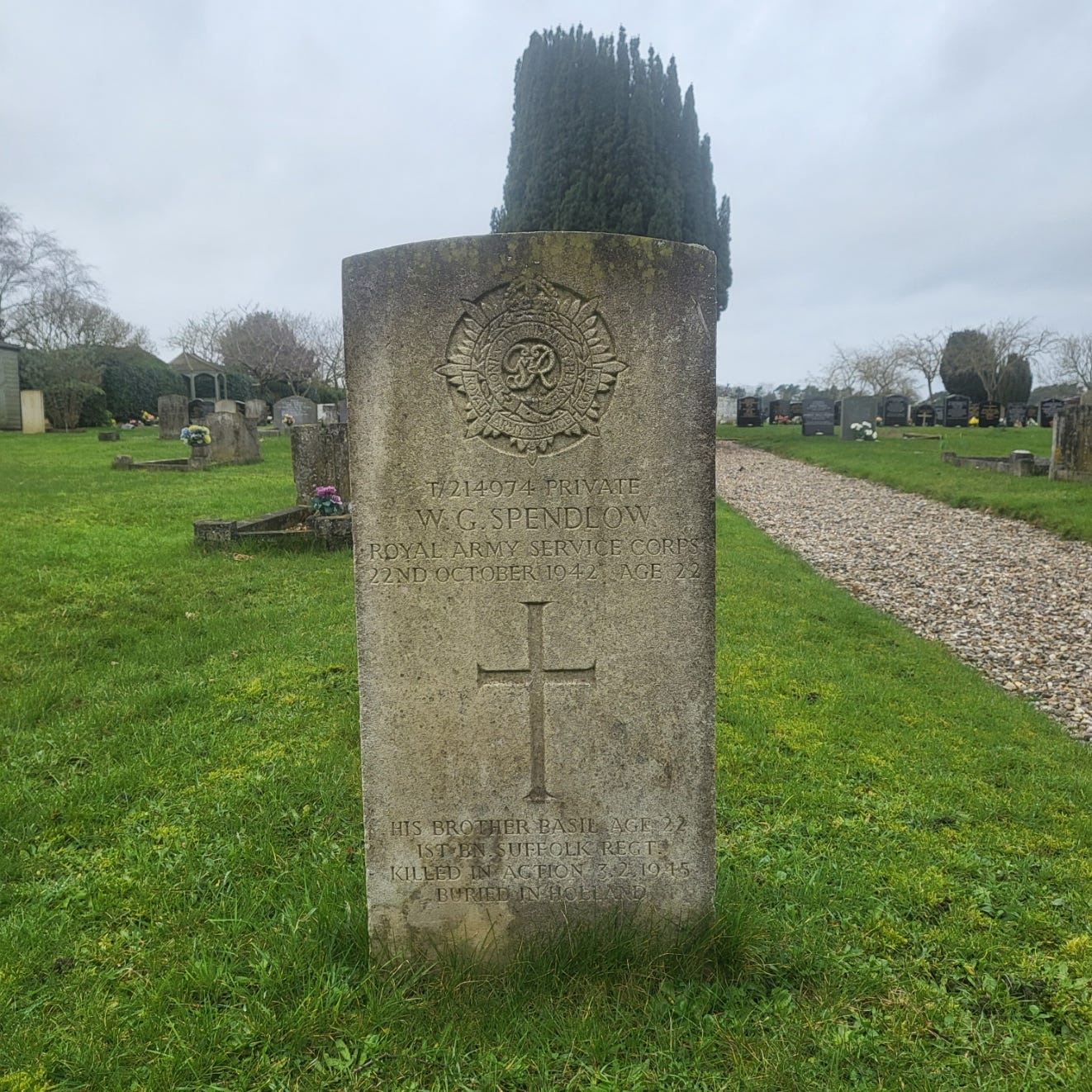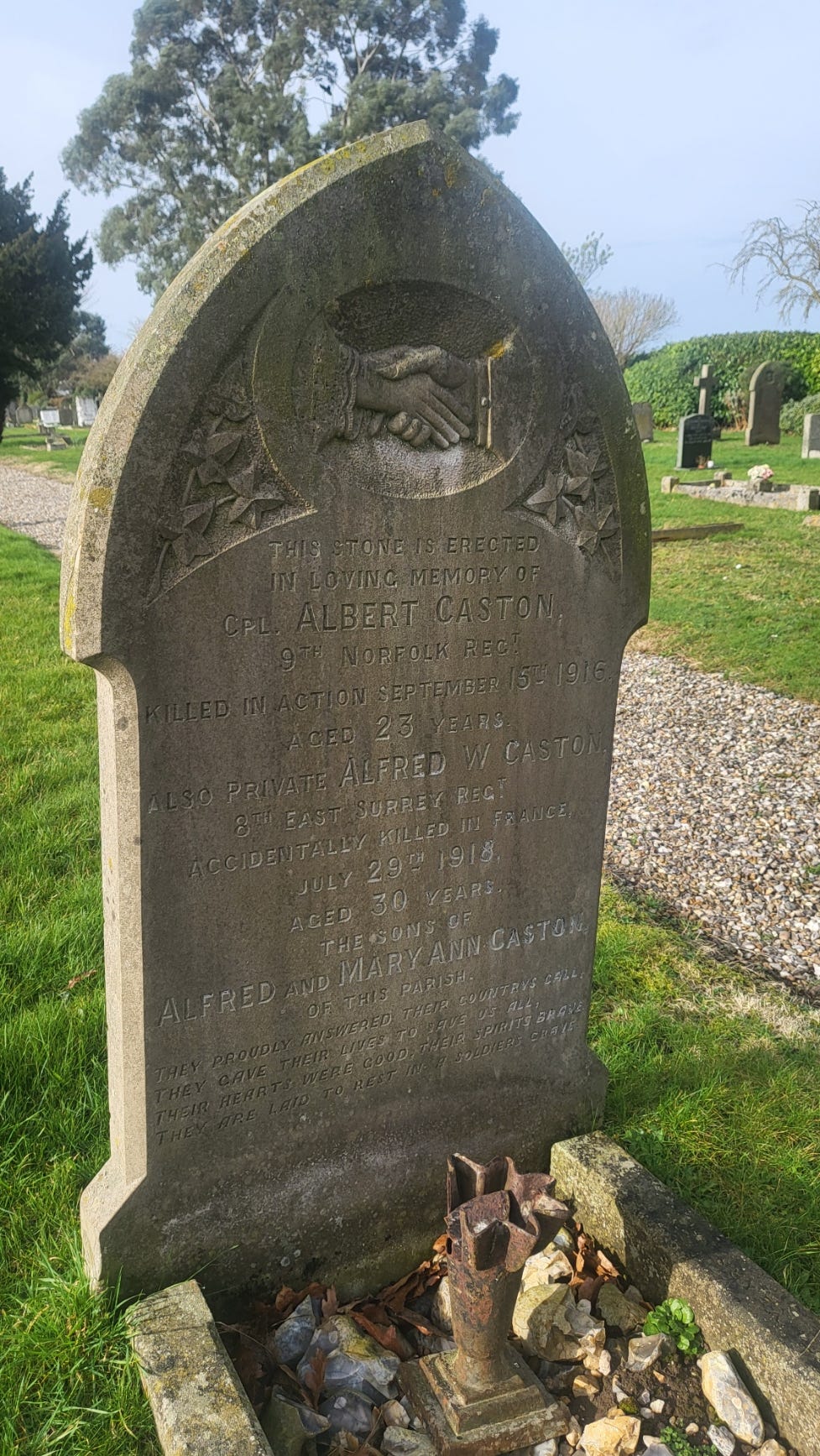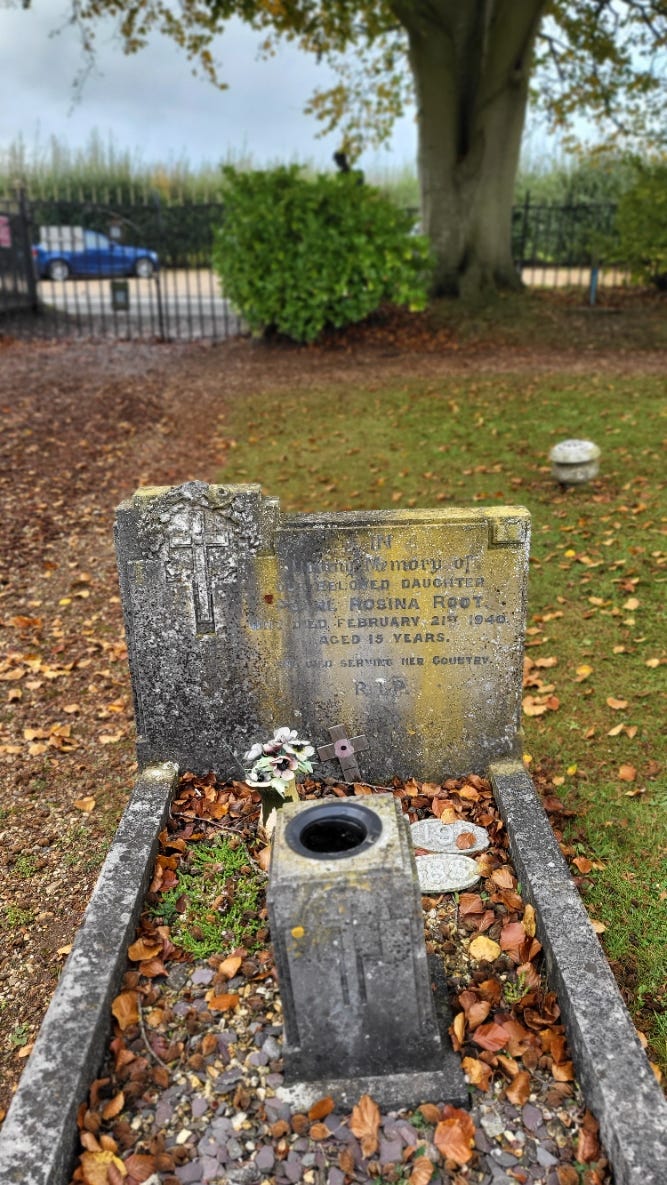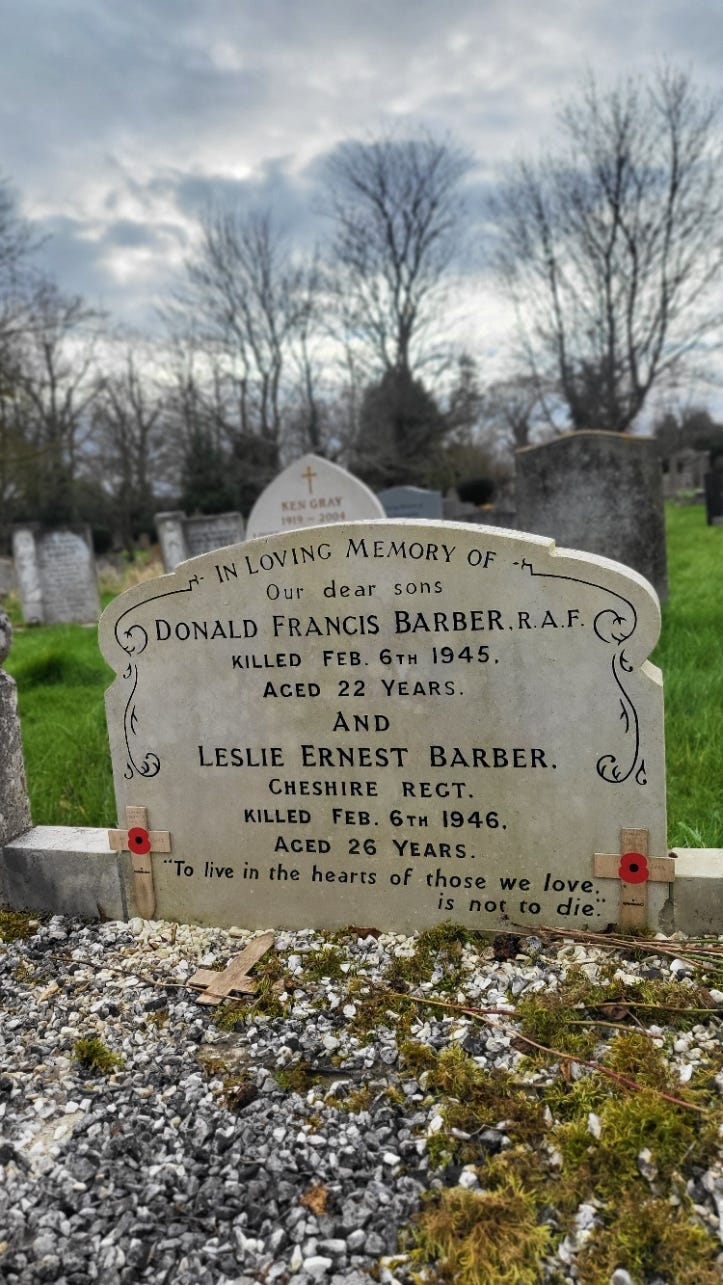Last year I did a bit of a NGL on one of my socials. I find it’s a good way of getting my brain out of a rut when I’m intellectually rotting into the ground. It forces me to think about something different, just for a moment. There are obviously the usual nonsense questions, the un-publishable ones, the ones trying to find out about my private life etc, etc, and (very) occasionally something pertinent to my work!
It was one of the latter I’m going to answer today.
-
The question was about epitaphs on graves and whether any stood out and stayed with me. I said at the time that it was too good a question to answer in a character limited platform and that I’d do an article on it sometime. So here we are.
I’m writing this today because it has occurred to me recently that sometimes, it’s the most unassuming of graves that actually ‘get’ to me the most. It’s not until you know the story behind the stone that the modesty of the words speaks louder than any grand monument.
First let’s look at a few that have stood out over the last year of graveyard visits. I shouldn’t be surprised, but almost all of the ones that have stuck with me over the year have been graves mentioning the loss of brothers, the loss of someone too young to be involved in war, and in one case, the loss of a month just a week after her sons passing.
It was on one of my first Norma Explores days out last year that I found myself in a burial ground, just outside the market town of Holt in North Norfolk. I’d had a shop there for more than four years, yet had never explored the cemetery on my doorstep. This was the first place that I started noticing headstones to families who lost more than one son to war.
I won’t do full bios on all of these chaps here, as it will inevitably put me over the word count allowed, so let me share their graves and promise to elaborate at a later date…
Private W. G. Spendlow (T/214974) Royal Army Service Corp
Died 22 October 1942 Age 22
Below it reads ‘His brother Basil Age 22 1st Bn Suffolk Regt. Killed in Action 3.2.45. Buried in Holland.’
So although they died a couple of years apart, neither made it past 22 years.
Next I found the grave of Corporal Albert Caston. 9th Norfolk Regiment. Killed in Action - September 15th 1915. Age 23 and his brother Private Alfred Caston. 8th East Surrey Regiment. Accidentally Killed in France. July 29th 1918. Aged 30 years.
The bottom of their headstone bears the inscription:
‘THEY PROUDLY ANSWERED THEIR COUNTRY’S CALL
THEY GAVE THEIR LIVES TO SAVE US ALL
THEIR HEARTS WERE GOOD, THEIR SPIRITS BRAVE
THEY ARE LAID TO REST IN A SOLDIER’S GRAVE’
The last of the Holt headstones I will share here is this one, which reads:
Robert Edward Nichols. Died of Wounds 13th March 1918
And
William Diver Nichols. Died in Action 29th September 1918
Both in France
What a horrific year that must have been for that family.
-
The next one isn’t a Commonwealth war grave, but is that of a young girl. Durrington Cemetery in Wiltshire has 230 identified war graves. It also has that of Pearle Rosina Root. Her grave would not have stood out had someone not stuck one of those Remembrance Day wooden crosses into the ground in front of it. On closer inspection the words ‘aged 15 – Died serving her country’ made my heart sink a little.
On the 19thst February 1940, Pearle and two of her friends returned from their lunch-break and took up their places at their work station in an aircraft factory (as it was described in the press) at Middle Woodford near Salisbury. It’s not known exactly what happened, but it’s speculated that one of the girls knocked a box of igniters underneath the bench, which triggered a spark. They were singing a song as they worked, when they suddenly heard a noise and saw smoke and flames coming from under the bench. One girl managed to flee with her clothing on fire, but two were seriously injured in the subsequent explosion. They were both taken to Salisbury infirmary. Pearle died within a day or so, and Doris soon after that. In a heartbreaking twist of fate, Pearle was originally meant to have gone to work at the infirmary, but changed her mind and went to work at the factory instead.
-
A few months ago I was in Sudbury, Suffolk. There are 27 identified Commonwealth War Graves here. It was at a fairly standard looking white CWGC headstone that became memorable with just a few lines close to the ground.
77035 Private E. P. Coote – Middlesex Regiment - 21st December 1918 Aged 38
ALSO HIS MOTHER WHO PASSED AWAY DEC 29TH 1918 RIP
Ernest Phillip Coote was born in Long Melford in 1882. He was raised by his mother and step-father. Before the war he worked as a soap-maker and then as a Barge Lighterman. Ernest initially join The Queen’s (Royal West Surrey) regiment, before transferring to the Middlesex Regiment and finally ending up with the Labour Corp. By the time the war ended his mother, Eliza, was widowed and surviving as a charwoman. Ernest died of disease on 21st December 1918 and his mother died a week later. I don’t know her cause of death, but I suspect the loss of her son contributed. If that disease was the influenza that was sweeping the globe, she could also have succumbed. Unfortunately, I don’t know. Although the records are sparse, it seems Eliza also had a daughter called Rose. She was Ernest’s half-sister, but by the time of her mother and brother’s death, she had long since left Suffolk. The 1911 census lists her as an unemployed maid servant, residing at St Marlyebone, a workhouse, in London. She was still in London when she died aged just 42 in 1930.
I feel for this family. The headstone in Sudbury cemetery is as simple as any of the Commonweath War Grave Commission ones, but that single line of text said so much more.
From Sudbury to Northamptonshire and the Cemetery in Oundle.
I’ve already covered a couple of the graves here in the course of making our daily YouTube Shorts. There are 13 identified Commonwealth War Graves to be found. The grave that stood out to me here was a family memorial, however. A large square marked out with two headstones. One headstone for the parents and one for two brothers. The inscription at the bottom read ‘To live in the hearts of those we love, is not to die.’ It was not the sentiment that stood out though, but the dates on the headstone.
IN LOVING MEMORY OF OUR DEAR SONS
DONALD FRANCIS BARBER R.A.F
KILLED FEB 6TH 1945 AGED 22 YEARS
AND
LESLIE ERNEST BARBER
CHESHIRE REGIMENT
KILLED FEB 6TH 1946 AGED 26 YEARS
I always wonder when I see family member dying on the anniversary of another’s death, if it might be connected. Directly, by suicide, or indirectly due to an accident while their mind was in it’s grief. Of course, we rarely find out, but still it’s a thought that sits with me.
Warrant Officer Donald Barber was flying with No 83 Group Support Unit at the time of his death. On 6th February 1945 he was pilot in an Avro Anson I NK499 with his navigator Flight Sergeant John Coleman. They suffered a double engine failure at low level and crashed into farmland near Kirdford, West Sussex.
A year later Leslie Barber, who had joined the army in 1941, was serving with the Cheshire Regiment in Algeria. Exactly a year to the day of his brothers death, he was involved in a car accident while in Algiers. He was buried in Dely Ibrahim War Cemetery and commemorated on the headstone in Oundle with his brother.
Incidentally, Flight Sergeant Coleman is also buried in Oundle Cemetery.
-
So onto the final grave which sticks in my mind, and once again it’s a pair of brothers. In a churchyard in Cornwall we find a grey cross sitting on a square base. The inscription reads:
SACRED TO THE MEMORY OF HARRY JANE
BORN JUNE 1ST 1883. DROWNED AT FALMOUTH JANUARY 1916
“UNTIL THE DAY BREAK”
AND OF HIS BROTHER
ARTHUR WHO WAS DROWNED IN THE MEDITERRANEAN
WHILST ON ACTIVE SERVICE
JANUARY 17TH 1916
AGED 22 YEARS
Naturally, with both brothers killed in the same month and both by drowning, I had to find out more. The story is one of the saddest set of circumstances I could imagine.
The brothers worked amongst the fishing fleet before the war and would join the Royal Naval Reserve as Deck Hands during the war. Arthur was serving on HM Trawler Fulmer and Harry on HM Trawler Fezenta.
The Fulmer was requisitioned in May 1915, armed and put into service as a minesweeper patrol vessel. In December 1915 the Albert and the rest of the crew of the Fulmer left for the Mediterranean theatre. On the 12th January she was sailing in company of another trawler to conduct patrols in the Gulf of Sollum. It was reported that the Fulmer had a faulty wireless and had been unable to receive messages from a sloop called the Mimosa that it was meant to have met up with. The two trawlers decided to continue patrolling independently and the Fulmer was last seen on the 14th January. Unfortunately, the Mimosa had been acting as escort to the Latona, a mine laying vessel. The patrol vessels had not been warned about the mines that were being laid in the area and so, when the Fulmer failed to show up, a search was made. On the 16th January a few bits of wreckage were found floating in the water, but nothing else. It was determined that HM Trawler Fulmer had hit one of the Latona’s mines and been destroyed. The crew of 16 were never recovered, including Arthur. Although all the men lost on the vessel have a deceased day as the 17th, it’s likely the Fulmer was destroyed on the 14th or 15th between its last known contact and the wrecked find.
Back in Falmouth, Harry was in the docks on the HM Trawler Fezenta. The Fezenta was built in 1914 and acquired by the admiralty in March 1915. On 17th January Harry left his ship to visit his cousin who was on board a different vessel in the docks. This was the last time he was seen. He was reported as absent on the 18th and a warrant was issued. He couldn’t have known about the loss of his brother just 24 hours before, but the timing of his disappearance is haunting. For almost a month he was just gone. Then, on Sunday 13th February his body was spotted floating in the water at the western breakwater. He was already in an advanced state of decomposition and it is likely he entered the water the day he went missing. The inquest was held and the jury returned a verdict of ‘Found Drowned’. It was however mentioned that he had been downhearted due to having to leave home. He was described as a very steady man. Whether it was an accident or something else we will never know, but let’s spare a thought for the parents of these brothers lost within days of each other.
-
With the exception of a few eloquent lines carved into the stone, it’s fair to say that the graves that have stuck with me the last twelve months have been the ones that tell the most tragic family histories. Once again I am reminded that the two world wars had so many more tales than those from the battlefield. Any one of these stories of loss could have been made into a meaningful TV drama. The lives of those at home go largely untold, but as personal stories go, they are the most heartbreaking. What is worse, these stories are repeated in almost every graveyard and cemetery in the UK.









